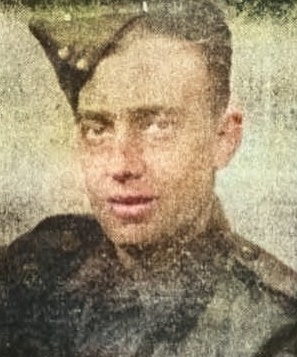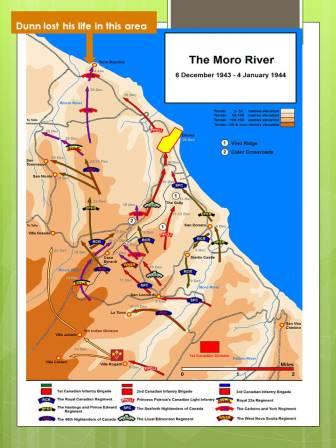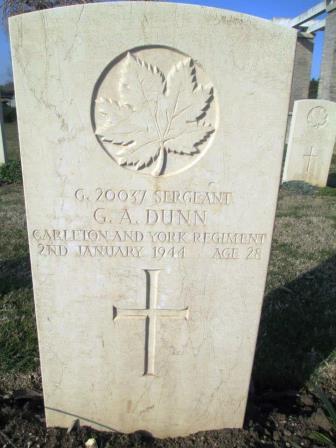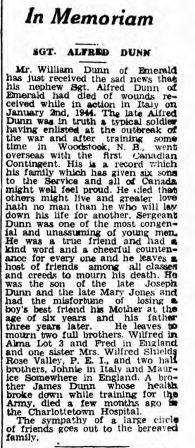March 10, 2020. Among the names listed on the Cenotaph outside of the Borden-Carleton Legion are 4 that died in Italy during WW2. One of these men was Ernest Murray Norton (see The Last Valentine From A WWII Soldier). This posting is about a young man who lost his life during the Battle of Moro.
George Alfred DUNN was born February 11, 1915 in Roseville, the son of Joseph J. Dunn and Mary Ellen Jones. Dunn didn’t have an easy life. His mother died when he was six. His father died when Dunn was only 9 years old, and he was brought up by his uncle, William Dunn, of Emerald Junction.
A woodsman before enlisting with the Carleton & York Regiment in St. Stephen, New Brunswick on September 8, 1939, he received training in Woodstock, New Brunswick and then went to Europe with the first Canadian contingent, sailing to England on December 8, 1939 aboard the S.S. ‘Monarch of Bermuda’, and arriving on December 17.

George Alfred Dunn. (Photo source: http://www.ancestry.com. Photo colourization: Pieter Valkenburg)
On May 8, 1941 he was temporarily attached for a month to the Guards Depot while at a Drill Instructors Course. Upon completion, he was sent to No.1 AFW RCOC in Aldershot for a few weeks while he completed a PT No. 32 Course. On October 18, 1941 he was promoted to Acting Lance Corporal. (NOTE: RCOC refers to Royal Canadian Ordnance Corps, a unit provisioning troops with the means to fight, such as uniforms, weapons and equipment. AFW refers to Army Field Workshop.)
On May 16, 1942 he was promoted to Corporal, then on November 1942 he received another promotion, to Lance Sergeant, and was sent for more training. On June 16, 1943 he was sent to Italy, and then, on August 25, 1943, he was promoted to Sergeant.
On December 6, 1943, Canadian forces, along with British, Indian, and New Zealand infantry divisions, began a series of large-scale assaults on major crossing points along the Moro River in Eastern Italy, with the objective of securing a large bridgehead along the defensive line. The intention was to breach the German Army’s Winter Line defensive system and advance to Pescara—and eventually Rome. (For more information see https://en.wikipedia.org/wiki/Moro_River_Campaign)
According to the War Diary of the Carleton & York Regiment for January 1944, the unit was in Ortona, Italy on January 1. The weather was “dull and cloudy all day with rain during the evening” the report read, which went on to summarize what happened on December 31, 1943. “The transport finds the going pretty heavy on account of the mud. ‘A’ Company, who suffered the greatest during the Battle of Point 59 was brought back to a rear position where ‘B’ Company was and ‘B’ Company was placed at the front.” One of those wounded on December 31, 1943 was Sgt Dunn. According to the casualty report, he received “shrapnel wounds to the right leg and multiple wounds to the face” while in action.
On January 2, 1944, Dunn died of injuries received in action during the Battle of Moro (Point 59). He’s buried at Moro River Canadian War Cemetery in Italy.

Map courtesy of http://www.canadiansoldiers.com

Grave of George Alfred Dunn at Moro River Canadian War Cemetery. (Photo source: http://www.findagrave.com)
According to his obituary in the ‘Charlottetown Guardian’ of February 3, 1944, page 5, Dunn was part of a family that was in service, with a brother who had died a few months earlier. “…He was a true friend and had a kind word and a cheerful countenance for every one…” it said.

Obituary from the Charlottetown Guardian of February 3, 1944.
No family of George Alfred Dunn has been found as yet, unfortunately. If you have information or photos to share please contact Pieter at dariadv@yahoo.ca or comment on the blog.
© Daria Valkenburg